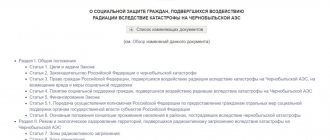Additional leave: cases and procedure for granting
“Human Resources Department of a Budgetary Institution”, 2010, N 5 Decree of the Government of the Russian Federation dated 01.10.2002 N 724 “On the duration of the annual basic extended paid leave provided to teaching staff.”
In Art. 116 of the Labor Code of the Russian Federation states that annual additional paid leave is provided to employees: - employed in work with harmful and (or) dangerous working conditions; - having a special nature of work; - with irregular working hours; — working in the Far North and equivalent areas; The need for additional paid leave may be established in an industry agreement.
The procedure for calculating vacation pay
The employee has the right to take all required vacation periods every year. At the same time, the right to receive the first main leave arises already 6 months after official employment.
To avoid confusion with vacation periods, the company always draws up a schedule that is valid for the entire calendar year. If necessary, changes can be made to it.
An employee who is entitled to additional paid leave has the right to combine it with the main one. You can divide the days, but only according to certain rules. It is important that each part of the vacation is at least 14 days.
In rare cases, an employee may be given leave in advance. This may be due to various situations, including by special agreement with the employer, but most often this method is used by part-time workers who want to take vacation at the same time from several jobs.
Features of the advance method:
- if we are talking about an employee who works on an irregular schedule, he is provided with advance days without problems at any time, even if he has worked for less than six months.
- for those who work in hazardous enterprises, a prerequisite for receiving such a vacation period will be working for at least 11 months.
By law, ML is a component of annual leave, therefore it is subject to all conditions of provision and payment. For example, a boss cannot demand the cancellation of vacation for an employee. Moreover, if necessary, you can transfer unused time to a later date.
However, it must still be the same calendar year. Otherwise, you will not be able to use the additional vacation period. If the employee does not want to use additional vacation this year, you can receive monetary compensation for it.
This is also taken into account upon dismissal, where the employee may receive additional payments. If the additional leave was issued in advance, the accounting department must withhold the required amount from the dismissed person.
All employees must be paid vacation pay before the start of their vacation. For ordinary workers, this must be done no later than three days before the start of the vacation. Such requirements are established by the Labor Code of the Russian Federation. For municipal employees, the payment period for vacation pay is different. According to Law 79-FZ, funds in the form of vacation pay must be paid to the employee no later than 10 days before the vacation.
In addition to the annual salary, bonuses for assignments of particular complexity and importance, as well as financial assistance, are also taken into account. However, they are not taken into account in full, but only in 1/12 of their total amount. The rest of the calculation procedure coincides with the calculation of vacation pay made for ordinary categories of employees.
Law Club Conference
revellies 07 Sep 2012 I am interested in 2 questions at once.
For example, clause 3.13 of the Federal Industry Agreement on organizations of the Ministry of Sports, Tourism and Youth Policy of the Russian Federation for 2009 - 2011, approved by the Ministry of Sports and Tourism of Russia, the Trade Union of Physical Culture, Sports and Tourism Workers of the Russian Federation 08.
Post edited by revellies: 07 September 2012 - 15:15
revellies 07 Sep 2012 As I understand this document, the text is below.
Namely, is the DECISION of October 25, 1974 N 298/P-22 in force? If yes, then the list includes: And, second question. An employee can break up the vacation with a mandatory 14-day one part, and break up the rest of the vacation without days off, i.e. 14 calendar days, but Monday through Friday and next week too? Best regards to the community and thanks in advance for your advice.
The legislative framework
| Law No. 25-FZ of 03/02/2007 | “On municipal service in the Russian Federation” |
| No. 79-FZ dated July 27, 2004 | “On the state civil service of the Russian Federation” |
| Resolution No. 562 of 09/06/2007 | “On approval of the rules for calculating the salary of federal civil servants” |
As mentioned above, the right to vacation is enshrined in the Constitution of the Russian Federation, namely in paragraph 5 of Article 37.
In addition, this provision is regulated by Labor legislation, specifically Chapter 19. The fact that a person is entitled to annual leave is stated in the Labor Code, Part 1, Article 122. Provisions on holidays and the correct calculation of vacation can be found in Article 115. Article 267 states that certain categories of employees have the right to a longer vacation period. This applies primarily to minors.
In addition to the main vacation, an officially employed employee can count on an additional paid period if he falls into a special category. All rules and regulations on this issue can be seen in Article 116 of the Labor Code of the Russian Federation. Here you can also find information about what extras are. vacation basically.
Additional information on each category of citizens who can count on one more vacation period per year is contained in articles 117, 118, 119, 321 and 322.
Resolution of the State Committee for Labor of the USSR and the Presidium of the All-Union Central Council of Trade Unions of October 25, 1974
.
something is not at all clear, i.e. There is no list and everything is vague about what is considered harmful, i.e.
N 298/P-22
“On approval of the list of industries, workshops, professions and positions with hazardous working conditions, work in which gives the right to additional leave and a shortened working day”
(with changes and additions).
N 298/P-22 “On approval of the list of industries, workshops, professions and positions with hazardous working conditions, work in which gives the right to additional leave and a shortened working day” September 13, November 1, 1977, January 30, 24, 29 May 1978, March 7, 1979, September 7, November 5, December 9, 1981, April 6, 1982, September 7, 1983, January 29, October 12, 26, November 5, 26, 1987 , February 16, 25, April 11, June 16, July 21, August 19, September 16, December 6, 1988
Additional paid leave
. For harmfulness Art. 116 of the Labor Code of the Russian Federation establishes that annual additional paid leave is provided to employees engaged in work with harmful and (or) dangerous working conditions, employees with a special nature of work, employees with irregular working hours, employees working in the regions of the Far North and equivalent to them localities, as well as in other cases provided for by the Labor Code of the Russian Federation and other federal laws. At the same time, the minimum duration of annual additional paid leave for employees engaged in work with harmful and (or) dangerous working conditions, and the conditions for its provision, are established in the manner determined by the Government of the Russian Federation.
We recommend reading: How length of service affects the calculation of early pension
In order to establish for employees engaged in heavy work, work with harmful and (or) dangerous and other special working conditions, reduced working hours, annual additional paid leave, and increased wages, certification results are used.
This is established by p.
Example of calculating vacation duration
The right to rest is one of the main rights granted to a citizen of the Russian Federation. The employer’s obligation to provide annual paid leave while maintaining the position and average earnings is enshrined in the Labor Code of the Russian Federation, namely Article 114. Chapter 19 of the Labor Code is generally devoted to the issue of leaves for all categories of citizens.
In addition to the general provisions, the rest of civil servants is regulated by Federal Law No. 79 of July 27, 2004 “On the State Civil Service of the Russian Federation.”
Or on the website. It's fast and free!
The procedure for calculating the vacation period and additional vacation days for special working conditions are given in Article 46 of the 79-FZ.
The duration of annual paid rest in accordance with the general rules of law is 28 calendar days, which does not include holidays.
Unlike ordinary workers, civil servants have a preference in terms of the duration of standard guaranteed rest. Until 2020, it depended on the level of the position held and was 35 days for managers and 30 for other employees.
However, in accordance with the amendments made to the regulatory legal act, the vacation of the entire category of citizens under consideration is 30 calendar days, regardless of the height of the position held.
However, the legislator leaves a reservation that, at the request of the employee, annual leave can be reduced, but nevertheless it must be at least 28 days.
Moreover, at the request of the employee, this period can be divided into several parts. The only condition is that it must be distributed in such a way that at least one of the parts lasts two weeks or more. The law is silent about the remaining days. Consequently, the employee has the right to divide the remaining period into any components he wishes.
In addition to the mandatory period, officials are entitled to additional rest. The provision of such bonus days depends on a number of factors that apply to a particular government employee.
Federal legislation clearly defines the time frame for which length of service is entitled to specific additional non-working days:
- For years of service from one to five years, an additional one day of vacation is provided.
- If an employee works for the benefit of the state from five to ten years, then he has the right to count on five calendar days of additional rest per year.
- If you have ten to fifteen years of experience, seven days are provided.
- More than 15 years of service provides a bonus in the form of ten vacation days.
We suggest you read: Is it worth getting a mortgage?
Special conditions of service, in particular, irregular working hours, are rewarded with three additional calendar dates of rest.
If there are dangerous or difficult working conditions, which include, in particular, service in an area with a harsh climate, additional vacation days are accrued in accordance with the requirements of the Labor Code of the Russian Federation. In accordance with Article 117 of the Labor Code, the duration of such leave is a week.
According to the general rule, the right to receive annual leave arises for a civil service employee who has worked in the organization for at least six months. In general, an employee can go on vacation for the 11 months of the year worked.
Exceptions to the rule are:
- employees before maternity leave or immediately after its completion;
- parents with many children;
- adoptive parents of young children under three months of age.
Additional vacations are summed up and added to the main mandatory period.
Employees go on vacation in accordance with the schedule drawn up before the start of the new year. This document must be approved no later than two weeks before the start of the year.
In exceptional cases, if there are valid reasons, it is possible to adjust the schedule and leave an employee outside the established period.
In addition, the employee has the right to leave at his own expense, the intention to receive which, indicating the reasons, is reported to the manager. It is worth noting that the maximum possible duration is a year.
Federal law, in part 10 of Article 46 79-FZ, establishes that funds must be paid to employees no later than 10 days before the start of the vacation.
Vacation pay is calculated based on the employee’s average daily earnings multiplied by the number of days of rest.
In addition to the basic salary, once a year an employee is entitled to financial assistance:
- in the amount of two monthly salaries for employees of federal authorities;
- payments in the amount established directly by the subject of the Russian Federation for an employee of the authorities of the mentioned subject.
Ivanov I.I. is a municipal employee. He was granted annual leave of 14 days from March 1, 2020. Ivanov is paid the following amounts monthly: salary - 16,000 rubles, bonus - 3,000 rubles, incentives - 5,000 rubles. For the previous year before his vacation, Ivanov was also paid bonuses in the amount of 20,000 rubles and financial assistance in the amount of 4,000 rubles.
16,000 3,000 5,000 (20,000 4,000)/12 = 26,000 rubles
26,000 / 29.3 x 14 = 12,423.21 rubles
Annual additional paid holidays
join the main vacation (Article 120 of the Labor Code of the Russian Federation).
Painting work XVI. Aviation and defense production XVII. Electrical production XVIII. Radio engineering and electronic production XIX. Production of thermometers and hydrometers XX. Diamond cutting production XXI. Jewelry production XXII. Production of building materials XXIII.
At the same time, the duration of the annual main and additional paid leaves of employees is calculated in calendar days and is not limited to the maximum limit. The duration of additional leave depends on the grounds and reasons for which leave is granted.
As already mentioned, in cases not provided for by law, an organization can independently establish additional paid leave for its employees.
Payment for such additional vacations is carried out at the expense of the organization and is not taken into account as part of the expenses taken into account when calculating the tax base for income tax (clause 24 of Article 270 of the Tax Code of the Russian Federation).
How is it reflected in the documents?
Considering that this period is part of the annual vacation time paid by the employer, it is recorded in all papers, just like the main vacation. Thus, HR department employees must enter data into the vacation schedule and time sheet for work permits. The data is also reflected in the employee’s personal card.
To grant leave, an order is drawn up using the unified form T-6. This document comes with a special note indicating the amount of payments for vacation and additional compensation that the employee is entitled to.
All paperwork must be completed quickly, since the employee receives vacation pay no later than the 3rd day of vacation. Delay in payment is considered a gross violation.
The personal card must contain data on the number of vacation days, the period worked and the basis for going on vacation. In the working time sheet additional. vacation is reflected by the digital code 10 or the letters OD.
Annual additional paid leave
- this is the rest time that is provided to the employee in addition to the annual basic paid leave. During such leave, the employee retains his average earnings.
Additional paid leave is divided into: Otherwise, labor disputes may arise among employees due to the unclear distribution of additional leave. The most common cases in which additional leave is required, as well as the duration of leave, are shown in the table below.










